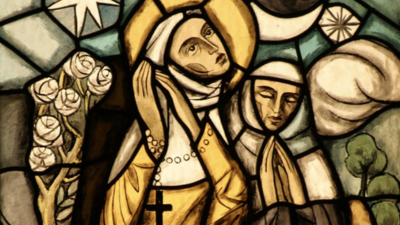The Conversion of Clare
St. Francis of Assisi
It was not only men who were inspired to “leave the world” and follow Francis. A daughter of landed aristocrats, Clare di Favarone di Offredicio wanted to follow Francis.

In the last several articles we have described the brothers who gathered around Francis and committed themselves to his way of following Christ. Two of the earliest arrivals were Leo and Rufino. The first became Francis’ chaplain and confessor, as Leo was an ordained priest already. Rufino, a lifelong confidant and wisdom figure for Francis, was also the first cousin of an aristocratic woman of Assisi, the niece of Monaldo, lord of Coriano. Clare di Favarone di Offredicio was a woman from the very class of landed aristocrats that the young Francis had imitated and longed to join socially.
In 1212, Clare was likely 18-years old. She lived in an age when thirteenth-century Italian women were carefully guarded by their parents, especially by aristocratic parents, in preparation for marriage or entrance into a convent. So it was unconventional at best that Clare sent word through her cousin Rufino that she wanted to meet Francis. One can only imagine what Francis expected from the meeting. In and around this time period, wealthy women were already becoming benefactors of the friars – although certainly not in an organized manner. Perhaps Clare also wanted to see how to support this nascent religious order of “lesser brothers.”
Francis agreed to meet Clare and talk about her plans. A meeting was arranged unbeknownst to Clare’s parents; she would come escorted by a chaperon, Lady Bona, as demanded by social mores. Francis came with Brother Philip as was also socially appropriate. Beyond that, we have no idea of the exact details of the conversations, all other reports being late and legendary. But it was clear that in this and/or a series of other meetings that followed, Clare wanted to live a life of vowed poverty working with the poor. We may guess at first that Francis thought this young woman, eleven years his junior, was seeking advice about joining a group of sisters of penance. It soon became clear she was proposing to join him and his small group at the Porziuncola. I doubt Francis saw that coming. Francis had hardly anticipated a religious order of men and had never contemplated a women’s branch of his movement.
Many meetings later, the result was a plan for Clare to “leave the world,” just as Francis had nearly seven years earlier.
On Palm Sunday morning, 1212, Clare attended Mass at San Rufino with the women of her family and received her palm branch from the hand of Bishop Guido. He gave it to her personally, because, it seems, in a fit of distraction she had failed to join the women’s line for the distribution of the palms. Perhaps Guido knew what was going on, and this was a signal that he approved. That night, accompanied by her sister Pacifica (Bona had departed on pilgrimage to Rome), Clare left the family’s house through a security door. This required moving away the bricks and beams blocking it. The choice of this exit, rather than the usual street door, suggests that Clare left home against the wishes of her parents or at least without their knowledge.
Clare and her sister arrived at the Porziuncola during the night. They found Francis and the community waiting for her in prayer before the candlelit altar. Francis cut the young woman’s hair and gave her a habit like that of the brothers, but with a veil. Before the ceremony, as Clare later recounted herself, she made a profession of religious obedience for life directly to Francis. Francis, like other religious leaders of the time, considered it normal that those entering monastic life make a vowed life commitment before they entered. There was nothing unusual about Clare’s profession, except that there was absolutely no provision for a woman to live at the Porziuncola. Francis now faced a new problem: what to do with his first female disciple. As on several other occasions of need, he turned to the Benedictines. He placed Clare among the nuns of San Paolo of Bastia, which was about two and a half miles outside of Assisi on the road to Perugia. They arrived late at night; this arrangement must have been planned well ahead of time, but it was, at best, a temporary expedient. Clare’s family soon found her at San Paolo and challenged her decision. She warned off her father and uncles by showing them her shaven head. They seem to have acquiesced in the decision without further protest.
Within a couple of days, Francis moved Clare again, this time to the Benedictine nuns of Sant’Angelo of Panzo, a mile-and-a-half trip out on the opposite side of Assisi. This monastery was under the jurisdiction of the abbot of Subasio, to whom the Porziuncola belonged. Francis seems to have made the new arrangements through his own landlord.
At Sant’Angelo of Panzo, Clare was joined by her sister Agnes, again without parental consent. This time the family arrived with soldiers to take both women home by force. Again, Clare succeeded in sweet-talking her father. He went home without his daughters. Francis then arrived publicly to perform Agnes’s vestition (putting on the religious habit) and take her profession of vows. Francis’s next move strongly suggests that Bishop Guido had been in on the plan from the beginning. Within a couple of months, Francis settled the two women on their own at the cathedral chapter’s church of San Damiano. It became the first convent of the female Franciscan movement. With episcopal protection, the women could live in peace. But their Franciscan journey was just beginning and would become unique in and of itself.